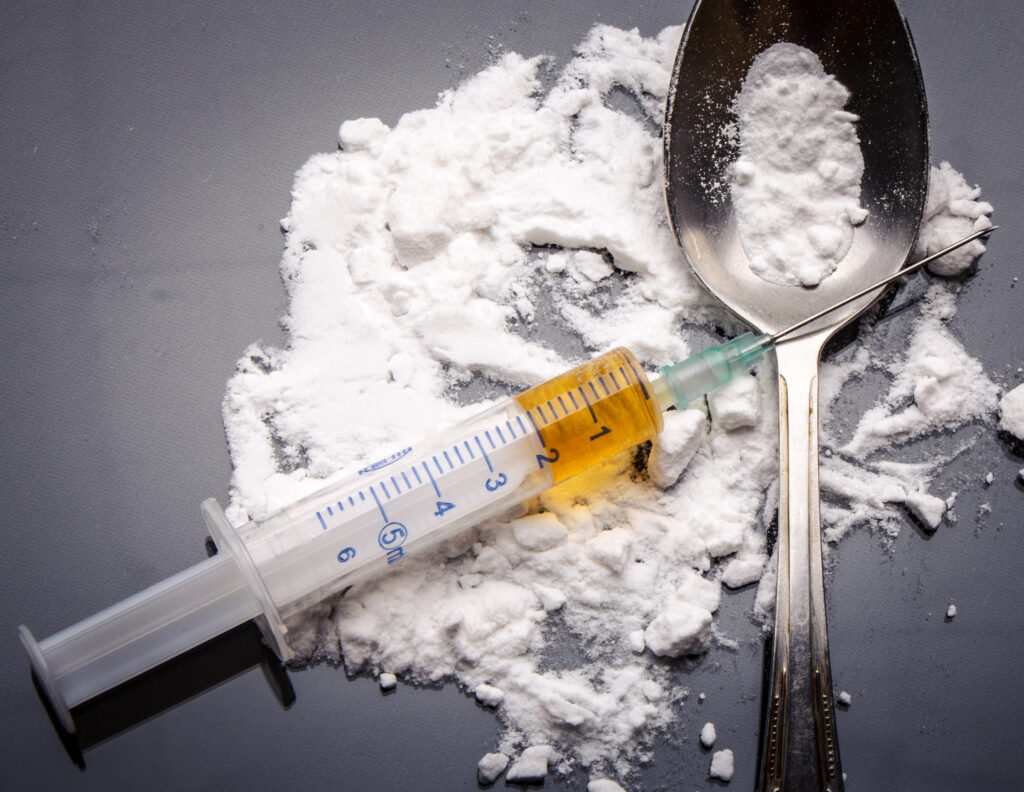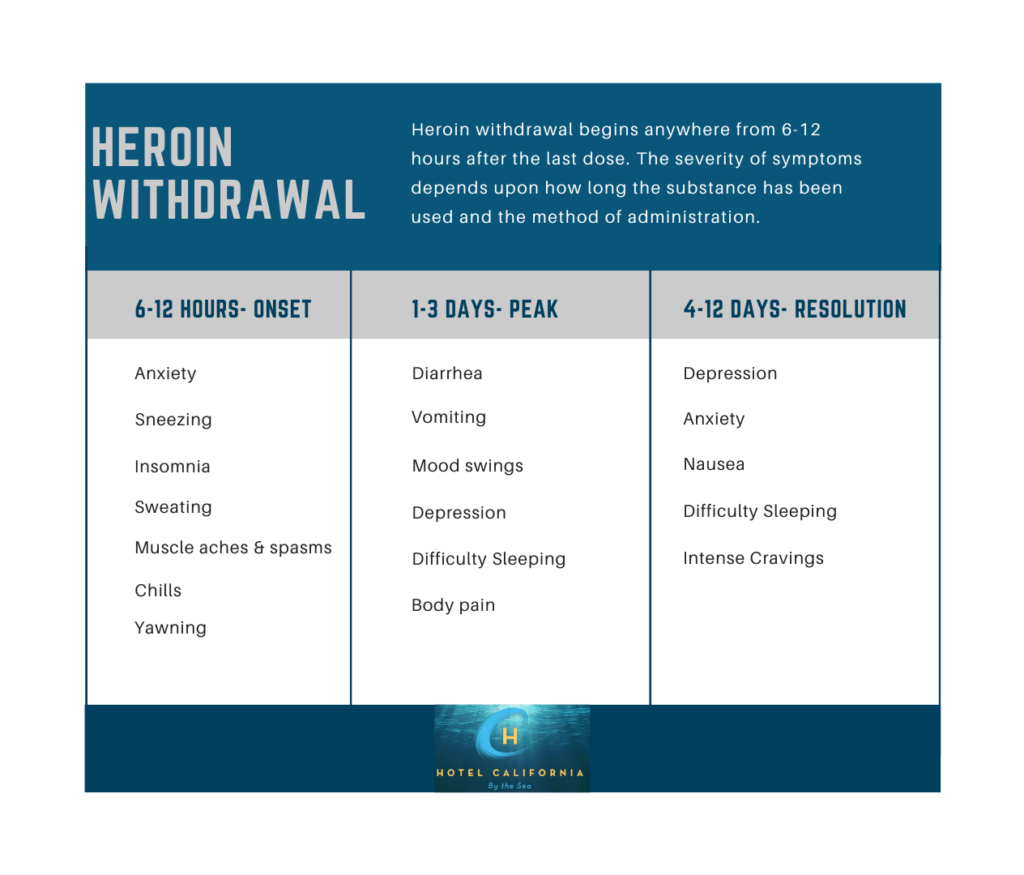How long does a Heroin High last?
Opioids have been at the forefront of the overdose drug crisis for the last few decades. It has become a public health epidemic in which prescription opioids as well as illicit opioids have led to more overdose and deaths than any other disease in recent history. Heroin, an illicit opioid drug, is one of the most addictive substances. According to the National Institute on Drug Abuse, in 2021, an estimated 1 million Americans aged 12 or older reported having a heroin use disorder in the last year. In the same year, about 9,173 Americans aged 12 or older reportedly died from a heroin overdose.

More about Heroin
Heroin is a highly addictive semi-synthetic opioid that is derived from morphine. Morphine is an alkaloid that is naturally occurring in poppy plants. Unlike other prescription opioid medications, heroin is not FDA-approved for any type of medicinal purpose and was created purely for recreational use. Common street names for heroin include Dope, H, Junk, White Horse, White China, Smack and Hell Dust.
Heroin comes in three forms, a white powder, a brown powder and black tar. White powder is the purest form of heroin and its appearance is similar to that of flour or sugar. Brown powder heroin is cheaper, less refined and the color is most similar to dust or chocolate milk. Black tar heroin contains the most impurities because of the way it is processed. The appearance resembles black roofing tar or a thick soy sauce liquid.
The drugs are most commonly cut or mixed with other substances. The most popular is fentanyl. Being cut with unknown substances in unknown amounts makes the drug even more dangerous because side effects can be unpredictable. Other additives in heroin do not easily dissolve into the heroin mixture and can result in clogging blood vessels that lead to organs such as the lungs, liver, kidney or brain. Cutting heroin with other substances is just one of the contributing factors to the current opioid epidemic.

Heroin works quickly. It doesn’t stay in the body for very long due to its short half-life and can be eliminated from the system in about a couple of hours. Its euphoric effects last for minutes while other sedative effects can linger on for several hours after the initial dose. The initial heroin high is part of the reason why so many users become addicted. However, the effects are so fleeting, that it causes users to continue to use more and more and put them at risk for addiction and overdose.
The potent and fast-acting opioid is also often mixed with other drugs to produce dangerous polydrug combinations. One such combination is called speedballing. Speedballing mixes heroin and cocaine in order to intensify the effects of both drugs. Heroin is a depressant, while cocaine is a stimulant. Contrary to the belief that the drugs would balance each other out, the combination of heroin and cocaine produces a tug-of-war of stress on the body and its organs.
How long does a Heroin high last?
Once heroin enters the brain, it is converted into morphine and binds with the opioid receptors. This is when users feel the rush of euphoria and pleasurable sensations. The intensity and duration of the heroin high or heroin rush is dependent on how much heroin is ingested, how fast the drug enters the brain and if there are any other drugs that were also taken.
When smoking heroin, the onset of a heroin high can begin within 10-15 minutes. With smoking, the duration of the effects can last for up to an hour or so. When shooting heroin directly into the veins, onset euphoria begins as soon as 7-8 seconds. When injecting heroin intramuscularly, the euphoric effects begin within 5-8 seconds. When heroin is injected or snorted, the effects can remain active longer and more intensely compared to other methods of administration.
The initial heroin high doesn’t last very long and on average has a duration of 10-15 minutes. After the initial euphoric heroin high wears off, sedative and relaxing effects kick in and can last between 4-5 hours. Users will feel drowsy, clouded mental function, slowed heart function as well as slowed breathing.
When abusing heroin, the initial high can be felt almost immediately, is extremely intense, but lasts for a very short period of time. Ultimately a heroin high does not last very long. Because of this, users who abuse the drug continue to take more despite the drug not being fully processed from the initial dose. This causes a toxic build-up of drugs and can easily lead to overdose.
Check Your Insurance Coverage for FREE
Find out if your insurance covers addiction treatment in minutes. We accept most insurance!
Side Effects of Heroin Abuse
- Flushed and itchy skin
- Dry mouth
- Nausea and vomiting
- The feeling of heavy limbs (arms and legs)
- Slowed and foggy mental cognition
- Lowered inhibitions
- Nodding off
- Collapsed vein
- Abscesses
- Damaged nostrils
- Lung disease
- Liver disease
- Kidney disease
- Infection of the tissue lining of the heart
- Lowered stress tolerance
- Difficulty with decision-making
- Less control over behaviors and actions
- Insomnia
- Anxiety and depression
More about Opioids
Heroin is a synthetic opioid. Opioids are common substances often found in prescription pain medications. They help relieve stress and provide relief of pain by affecting the central nervous system and blocking pain signals in the brain. However, opioid drugs are highly habit-forming and users can easily develop an addiction even though it is taken through a doctor-recommended prescription. Opioid abuse can reinforce drug-taking behaviors by affecting the limbic system, which is in charge of controlling emotions. Opioid abuse can depress breathing through its impact on the neurochemical activities in the brain stem. This is where automatic body functions are controlled.
Reach out to Hotel California by the Sea
We specialize in treating addiction and other co-occurring disorders, such as PTSD. Our Admissions specialists are available to walk you through the best options for treating your addiction.
Treatment of Heroin Use Disorder
Opioid addiction can be very difficult to overcome. Some users are addicted while other users are dependent. There is a difference. People who are addicted continue to take higher or more frequent doses of opioids like heroin, in order to achieve the desired euphoric effects. People who are dependent on opioids like heroin are taking the drug in order to avoid experiencing painful and uncomfortable withdrawal symptoms. They continue taking the drug in an attempt to feel “normal.”
Professional behavioral health programs such as Hotel California by the Sea provide exceptional treatment for people who are experiencing opioid use disorder and especially heroin use disorder. Clients can choose from various levels of care including detox, inpatient residential and outpatient programming. We also incorporate evidence-based treatment methods such as cognitive behavioral therapy, group therapy and family therapy. Often people who experience any type of substance use disorder, also experience co-occurring mental health disorders. By treating both conditions simultaneously, clients will have a greater chance of a successful recovery. Hotel California by the Sea provides the support, tools and resources for clients to overcome their substance use disorder.
References:
https://nida.nih.gov/publications/research-reports/heroin/what-are-immediate-short-term-effects-heroin-use
https://www.bicyclehealth.com/opioid-education/heroin/how-long-in-your-system
https://anrclinic.com/blog/how-long-does-heroin-stay-in-your-system/
https://www.drugrehab.com/addiction/drugs/heroin/heroin-in-system/
https://www.healthline.com/health/substance-use/what-is-heroin
https://www.talktofrank.com/drug/heroin
https://www.verywellmind.com/what-to-expect-from-heroin-withdrawal-22049
